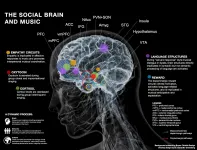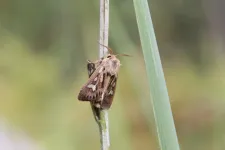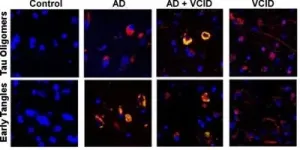(Press-News.org) An estimated 8 million tons of plastic trash enters the ocean each year, and most of it is battered by sun and waves into microplastics--tiny flecks that can ride currents hundreds or thousands of miles from their point of entry.
The debris can harm sea life and marine ecosystems, and it's extremely difficult to track and clean up.
Now, University of Michigan researchers have developed a new way to spot ocean microplastics across the globe and track them over time, providing a day-by-day timeline of where they enter the water, how they move and where they tend to collect.
The approach relies on the Cyclone Global Navigation Satellite System, or CYGNSS, and can give a END
Ocean microplastics: First global view shows seasonal changes and sources
Satellites reveal fluctuation in the Great Pacific Garbage Patch and releases from the Yangtze River
2021-06-10
ELSE PRESS RELEASES FROM THIS DATE:
Study shows how rudeness leads to anchoring, including in medical diagnoses
2021-06-10
Have you ever been cut off in traffic by another driver, leaving you still seething miles later? Or been interrupted by a colleague in a meeting, and found yourself replaying the event in your head even after you've left work for the day? Minor rude events like this happen frequently, and you may be surprised by the magnitude of the effects they have on our decision-making and functioning. In fact, recent research co-authored by management professor Trevor Foulk at the University of Maryland's Robert H. Smith School of Business suggests that in certain situations, incidental rudeness like this can be deadly.
In "Trapped ...
Leaders who embrace on-job learning and listen to employees have more resilient teams, research show
2021-06-10
HOUSTON - (June 10, 2021) - Leaders who encourage their employees to learn on the job and speak up with ideas and suggestions for change have teams that are more effective and resilient in the face of unexpected situations, according to new research from Rice University and the University of Windsor.
"A Resource Model of Team Resilience Capacity and Learning" will appear in a special issue of Group & Organization Management. Authors Kyle Brykman, an assistant professor at the Odette School of Business at the University of Windsor, and Danielle King, an ...
What happens in the brain when people make music together?
2021-06-10
Music is a tool that has accompanied our evolutionary journey and provided a sense of comfort and social connection for millennia. New research published today in the American Psychologist provides a neuroscientific understanding of the social connection with a new map of the brain when playing music.
A team of social neuroscientists from Bar-Ilan University and the University of Chicago introduced a model of the brain that sheds light on the social functions and brain mechanisms that underlie the musical adaptations used for human connection. The model is unique because it focuses on what happens in the brain when people make music together, rather than when they listen to music individually.
The research was inspired by creative efforts of people around the world to reproduce ...
Case study shows patient on ketogenic diet living fully with IDH1-mutant glioblastoma
2021-06-10
Chestnut Hill, Mass. (6/10/2021) - A British man who rejected the standard of care to treat his brain cancer has lived with the typically fatal glioblastoma tumor growing very slowly after adopting a ketogenic diet, providing a case study that researchers say reflects the benefits of using the body's own metabolism to fight this particularly aggressive cancer instead of chemo and radiation therapy.
Published recently in the journal Frontiers in Nutrition, the report is the first evaluation of the use of ketogenic metabolic therapy (KMT) without chemo or radiation interventions, on a patient diagnosed with IDH1-mutant glioblastoma (GBM). Ketogenic therapy is a non-toxic nutritional approach, viewed as complementary or ...
Florida Python Hunters May Have a New Tool Thanks to Optics Research at UCF
2021-06-10
Just as the governor announced the start of python hunting season in Florida this month, researchers at the University of Central Florida have published a first- of-its-kind study that shows that near-infrared (NIR) spectrum cameras can help hunters more effectively track down these invasive snakes, especially at night.
The snakes, which can reach 26 feet in length and 200 pounds, have invaded the Everglades in Florida -- threatening native species and disrupting the ecosystem. The number of common native species observed in the Everglades since the snakes were first discovered in the 1990s dropped in some species by 90% through 2010, according ...
Novel liquid crystal metalens offers electric zoom
2021-06-10
ITHACA, N.Y. - Researchers from Cornell University's School of Applied and Engineering Physics and Samsung's Advanced Institute of Technology have created a first-of-its-kind metalens - a metamaterial lens - that can be focused using voltage instead of mechanically moving its components.
The proof of concept opens the door to a range of compact varifocal lenses for possible use in many imaging applications such as satellites, telescopes and microscopes, which traditionally focus light using curved lenses that adjust using mechanical parts. In some applications, moving traditional glass or plastic lenses ...
Butterflies and moths have difficulty adjusting to a rapidly changing climate
2021-06-10
Climate change exerts great pressure for change on species and biodiversity. A recent study conducted by the University of Helsinki and the Finnish Environment Institute indicates that the few moth and butterfly species (Lepidoptera) capable of adjusting to a changing climate by advancing their flight period and moving further north have fared the best in Finland. In contrast, roughly 40% of Lepidoptera species have not been able to respond in either way, seeing their populations decline.
Climate change is bringing about rapid change in Finnish nature - can species keep up with the pace? Adjusting to climate change can manifest through earlier phenology such as moth and butterfly flight periods, bird nesting, or ...
Forget me not: Novel target shows promise in treating Alzheimer's and related dementias
2021-06-10
Researchers remain perplexed as to what causes dementia and how to treat and reverse the cognitive decline seen in patients. In a first-of-its-kind study, researchers at the Medical University of South Carolina (MUSC) and Beth Israel Deaconess Medical Center (BIDMC), Harvard Medical School discovered that cis P-tau, a toxic, non-degradable version of a healthy brain protein, is an early marker of vascular dementia (VaD) and Alzheimer's disease (AD). Their results, published on June 2 in Science Translational Medicine, define the molecular mechanism that causes an accumulation of this toxic protein. Furthermore, they showed that ...
Music listening near bedtime disruptive to sleep, Baylor study finds
2021-06-10
WACO, Texas (June 9, 2021) - Most people listen to music throughout their day and often near bedtime to wind down. But can that actually cause your sleep to suffer? When sleep researcher Michael Scullin, Ph.D., associate professor of psychology and neuroscience at Baylor University, realized he was waking in the middle of the night with a song stuck in his head, he saw an opportunity to study how music -- and particularly stuck songs -- might affect sleep patterns.
Scullin's recent study, published in Psychological Science, investigated the relationship between music listening and sleep, focusing on a rarely-explored mechanism: involuntary musical imagery, or "earworms," when a song or tune replays ...
Study identifies how COVID-19 linked to Alzheimer's disease-like cognitive impairment
2021-06-10
June 10, 2021, CLEVELAND: A new Cleveland Clinic-led study has identified mechanisms by which COVID-19 can lead to Alzheimer's disease-like dementia. The findings, published in Alzheimer's Research & Therapy, indicate an overlap between COVID-19 and brain changes common in Alzheimer's, and may help inform risk management and therapeutic strategies for COVID-19-associated cognitive impairment.
Reports of neurological complications in COVID-19 patients and "long-hauler" patients whose symptoms persist after the infection clears are becoming more common, suggesting that SARS-CoV-2 (the virus that causes COVID-19) may have lasting effects on brain function. However, it is not yet well understood how the virus leads to neurological issues.
"While some studies suggest ...
LAST 30 PRESS RELEASES:
Beyond small data limitations: Transfer learning-enabled framework for predicting mechanical properties of aluminum matrix composites
Unveiling non-thermal catalytic origin of direct current-promoted catalysis for energy-efficient transformation of greenhouse gases to valuable chemicals
Chronic breathlessness emerging as a hidden strain on hospitals
Paleontologists find first fossil bee nests made inside fossil bones
These fossils were the perfect home for ancient baby bees
Not everyone reads the room the same. A new study examines why.
New research identifies linked energy, immune and vascular changes in ME/CFS
Concurrent frailty + depression likely boost dementia risk in older people
Living in substandard housing linked to kids’ missed schooling and poor grades
Little awareness of medical + psychological complexities of steroid cream withdrawal
Eight in 10 trusts caring for emergency department patients in corridors, finds BMJ investigation
NASA’s Webb telescope finds bizarre atmosphere on a lemon-shaped exoplanet
The gut bacteria that put the brakes on weight gain in mice
Exploring how patients feel about AI transcription
Category ‘6’ tropical cyclone hot spots are growing
Video: Drivers struggle to multitask when using dashboard touch screens, study finds
SLU research shows surge in alcohol-related liver disease driving ‘deaths of despair’
Rising heat reshapes how microbes break down microplastics, new review finds
Roots reveal a hidden carbon pathway in maize plants
Membrane magic: FAMU-FSU researchers repurpose fuel cells membranes for new applications
UN Member States pledge to increase access to diagnosis and inhaled medicines for the 480 million people living with COPD
Combination therapy shows potential to treat pediatric brain cancer ATRT
Study links seabird nesting to shark turf wars in Hawai‘i
Legal sports betting linked to sharp increases in violent crime, study finds
Breakthrough AI from NYUAD speeds up discovery of life-supporting microbes
New Eva Mayr-Stihl Foundation funding initiative boosts research at University of Freiburg on adaptation of forests to global change
The perfect plastic? Plant-based, fully saltwater degradable, zero microplastics
Bias in data may be blocking AI’s potential to combat antibiotic resistance
Article-level metrics would provide more recognition to most researchers than journal-level metrics
Satiety’s little helper: Protein that supports appetite regulating protein identified
[Press-News.org] Ocean microplastics: First global view shows seasonal changes and sourcesSatellites reveal fluctuation in the Great Pacific Garbage Patch and releases from the Yangtze River





